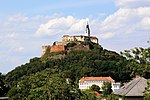Prägrad Castle
- View a machine-translated version of the German article.
- Machine translation, like DeepL or Google Translate, is a useful starting point for translations, but translators must revise errors as necessary and confirm that the translation is accurate, rather than simply copy-pasting machine-translated text into the English Wikipedia.
- Do not translate text that appears unreliable or low-quality. If possible, verify the text with references provided in the foreign-language article.
- You must provide copyright attribution in the edit summary accompanying your translation by providing an interlanguage link to the source of your translation. A model attribution edit summary is
Content in this edit is translated from the existing German Wikipedia article at [[:de:Burgruine Prägrad]]; see its history for attribution. - You may also add the template
{{Translated|de|Burgruine Prägrad}}to the talk page. - For more guidance, see Wikipedia:Translation.
| Prägrad Castle | |
|---|---|
Burgruine Prägrad | |
| Carinthia, Austria | |
 | |
| Type | Hillside castle |
| Site information | |
| Owner | Private |
| Open to the public | Yes |
| Condition | Ruin |
| Site history | |
| Built | 12th century |
Prägrad Castle (German: Burgruine Prägrad, from Slavic for outer ward) is a ruined medieval castle in Carinthia, Austria. It is located near Feldkirchen on a hillside above the road to Lake Ossiach.
The fortress was mentioned in an 1166 deed when the Nuremberg burgrave Conrad II of Raabs sold it to the Franconian Bishops of Bamberg, who then held large estates in the Duchy of Carinthia. Prägrad served as an administrative seat of Bamberg ministeriales, controlling the traffic on the road along the southern shore of Lake Ossiach to Villach. The Carinthian dukes had acquired the premises by 1258.
Temporarily owned by the Carinthian Counts of Ortenburg, the castle passed to the Counts of Celje in the late 14th century. Upon the death of Count Ulrich II in 1456, it was seized by the Habsburg emperor Frederick III who leased it to the Bishops of Gurk. From 1628 the estates were enfeoffed to Ossiach Abbey.
Remnants of the inner bailey, erected around 1200, and several outer walls are preserved. The remains of a Zwinger laid out about 1400 are visible to the southeast of the complex
See also
References
Burgenland 






Carinthia Lower Austria Salzburg Styria Tyrol Upper Austria Vorarlberg
 | This Carinthia location article is a stub. You can help Wikipedia by expanding it. |
- v
- t
- e











